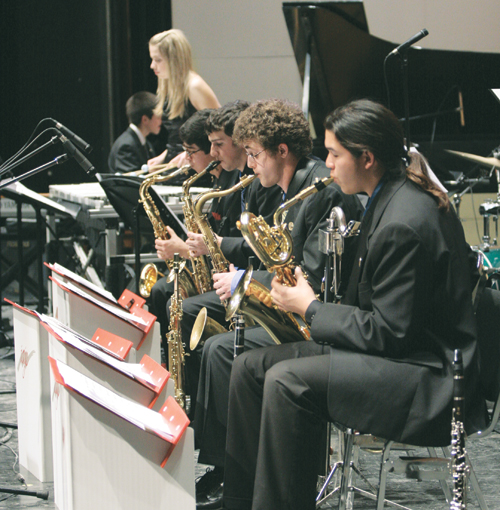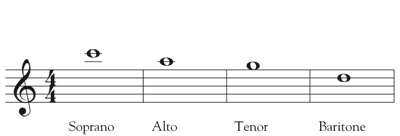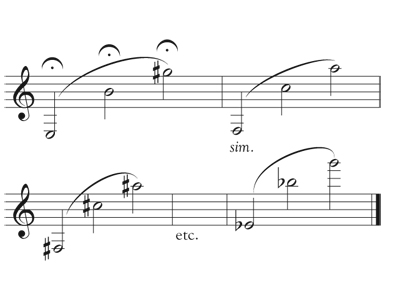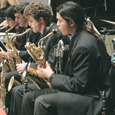
Woodwind doubling is a valuable pursuit that creates new opportunities for woodwind players. For players interested in doubling, pairing the clarinet and the saxophone makes sense because the instruments have a close relationship and several ready-made doubling opportunities exist.
Learning a Second Instrument
Although clarinet playing and saxophone playing have some common ideas and approaches, they are separate instruments with distinct traditions and should be approached as such. Some prospective doublers may worry that adding a second instrument will be detrimental to playing the first and may even have been warned away from doubling by a well-meaning teacher. There is no reason to be concerned that one embouchure will be ruined by learning another, or that learning a new set of fingerings will cause an old set to be forgotten. The lips, tongue, and fingers are more than able to carry out more than one task.
The greatest technical difficulty in switching between instruments is simply getting into the correct mindset for each one. A clarinet-like embouchure produces a poor sound on the saxophone, and a saxophone-like approach to fingerings will be less effective on the clarinet. However, if these techniques have been thoroughly and correctly practiced, a musician can easily switch between the two.
The best way to learn a second instrument is under the advice of a private teacher. A clarinetist who has spent years studying the instrument cannot expect to master the saxophone in a matter of weeks or months without instruction. When beginning study of a second instrument, establish a regular practice routine supported by weekly lessons, and work gradually from the most basic materials to the more difficult. It is crucial to be a beginner on each instrument. There are no shortcuts. Some fundamental concepts may be carried over in a theoretical way, but they will still require practice to apply them to the new instrument.
In any case, the aspiring doubler’s greatest advantages in learning another instrument have little to do with superficial similarities in technique, but much to do with general experience as a student and musician. An accomplished musician studying a second instrument will already understand the value of methodical daily practice, development of a strong tone through years of listening, and the use of technique as a means to expression.
The only genuine harm caused by playing a second instrument is in spreading resources too thinly, because practice time must be divided between instruments. However, with patience a doubler dedicated to the craft can, in the long term, play as well as the best saxophonists and the best clarinetists.
Equipment
Obtain the best possible instrument and accessories. A common misstep is to seek out equipment labeled for doublers. A clarinet mouthpiece advertised this way will likely have some saxophone-like characteristics in an effort to make the mouthpiece work better with a saxophone-like approach to playing. This may seem like a tempting shortcut, but it breeds laziness in learning a true clarinet embouchure and inhibits development of genuine clarinet technique.
Other equipment may be marketed to doublers due to purported qualities like easy response or effortless intonation seem to imply that purchase guarantees success without additional effort. In short, the best clarinet mouthpiece for doublers is ultimately just the best clarinet mouthpiece.
Another common mistake is ill-informed equipment choices. While clarinets from one instrument maker might be embraced by fine clarinetists, this is no guarantee that saxophones from the same maker are equally well regarded. This applies to mouthpieces and other accessories, as well as pedagogical materials and repertoire. The best approach is to seek the advice of a qualified private teacher before making purchases.
Voicing
Proper voicing technique, or tongue position, is often overlooked, but it is fundamental to response, intonation, and tone. Because voicing happens inside the body, it cannot be easily observed, but it can be understood in terms of some common activities. We use the mechanisms of voicing to produce different vowel sounds when we speak, to produce different pitches when whistling, or to blow air of different temperatures. Proper voicing of each instrument should generally be stable and require little change while playing; only the smallest adjustments are made to adjust pitch of individual notes or to ease some transitions between registers.
Incorrect voicing is one of the biggest obstacles for clarinetists learning to play the saxophone and vice versa. The clarinet’s voicing is extremely high, and most other wind instruments (flutes, double reeds, brasses) use a voicing that is quite low. Saxophones require a voicing target somewhere in between. Saxophone voicing is sometimes described as being similar to an oo or er vowel, but the best way to establish the correct voicing is to find the correct mouthpiece pitch. When a note is played on the mouthpiece alone, the following concert pitches should sound for soprano, alto, tenor, and baritone saxophones:

Warm air lowers the mouthpiece pitch, and cooler air raises it. This may take some practice; just a few minutes per day over several weeks is recommended to avoid straining. The pitch should not be adjusted by opening or closing the jaw or tightening or loosening the embouchure, as these actions make both tone and response worse.
For saxophonists playing the clarinet, voicing problems often result in an unstable pitch tending toward flatness, a tubby and uncharacteristic tone, and poor response in the upper registers. The clarinet’s voicing should be as high as comfortably possible, as though attempting to blow fast-moving, ice-cold air. This exercise may help saxophonists learning to play the clarinet:

All three notes in each grouping should respond readily, clearly, and reasonably in tune. If the higher notes are difficult or significantly flat, the voicing is likely too low. Note that the voicing should be high for the entire exercise, not just for the high notes.
Embouchure
The clarinet and the saxophone embouchures are formed with the muscles of the lips around the mouthpiece and reed; any pressure exerted should come from these precise muscles, rather than from the jaw. The lips form a seal around the mouthpiece and reed that is just barely airtight, preventing air leaks but also allowing the reed to vibrate.
There is a prevalent misconception that the lower lip rolls over the lower teeth to be used as a cushion between the teeth and reed, but if the teeth are pressing into the lip, causing pain and ultimately callousing, then the reed is not being permitted to vibrate freely enough. Excessive jaw pressure is to blame for this. The jaw should be opened enough that the lips can form the embouchure without the interference (sometimes mistakenly characterized as support) of the lower teeth.
The first embouchure difficulty for clarinet-saxophone doublers is the significant difference in mouthpiece angle. The clarinet is held at a relatively steep angle, generally within about 30° of vertical. This can give the impression of an embouchure in which the player is attempting to pry out the front teeth (although no such pressure should be applied). The saxophone’s mouthpiece angle is much more horizontal, although it does angle somewhat upward into the embouchure. To find this angle, assume a good upright posture, allow the saxophone to hang from the neckstrap, and then situate the right hand on the keys. Bring the right hand forward until the right hand and arm are in a comfortable, natural position, usually with the hand a bit in front of the body, with the right thumb applying some forward pressure on the instrument. Then adjust the neckstrap until the tip of the mouthpiece comes directly to the mouth.
The difference in mouthpiece angle raises two primary concerns for doublers. The first is posture, as there is a tendency for saxophonists to allow the head to bow downward when playing the clarinet and a tendency for clarinetists to allow the right hand to drift backward when playing the saxophone. In both cases this allows the player to fall back on a more familiar but incorrect mouthpiece angle.
Mouthpiece angle also affects articulation. The tip of the reed has a somewhat different location inside the mouth for the clarinet than it does for the saxophone, and the precise tongue movements for articulation must be adjusted accordingly. Articulation must be carefully practiced and refined on each instrument separately to ensure that it is light, fast, and efficient.
There is a myth that the clarinet’s embouchure should be tighter and the saxophone’s looser. This is best understood as a miscommunication of the instruments’ differing approaches to voicing. In both cases the embouchures, formed by the lips, should be just tight enough to prevent air leakage.
The amount of mouthpiece taken into the mouth is another area of concern, as it is a habit easily transferred erroneously to a new instrument. The exact amount of mouthpiece to take in varies depending on the specific mouthpiece. In general, single reed players struggling with muffled tone and limited upper dynamic range should try taking in a little more of the mouthpiece, and those with blaring tone and limited softer dynamics should experiment with taking in less mouthpiece.
Another method for determining the approximate amount of mouthpiece to take into the mouth is to slide a piece of paper between the reed and mouthpiece just until it stops, at the point where reed and mouthpiece meet. This location is a good starting point for further experimentation on where on the reed to place the lower lip.
Finger Technique
For both clarinet and saxophone, finger movements should be relaxed, efficient, and precise. Some doublers think that learning another instrument’s fingerings is simply a matter of memorizing a fingering chart, but this is far from the truth. Fingering patterns should be conscientiously trained until they feel automatic and natural, and there are no shortcuts to this. Even the most accomplished musicians, when learning a new woodwind instrument, should work through a beginner-level method book first, playing each exercise with care, and then work on intermediate through advanced technical and expressive studies. Moving too quickly to advanced material leaves serious gaps in technique.
There are some considerations on finger height that are important to doublers. For the clarinet in particular, keeping the fingers reasonably close to the toneholes is necessary for accuracy. As the fingers stray from the holes, it becomes more difficult to return the fingers to those holes with precision. Squeaking, a common problem for beginning clarinetists, is frequently blamed on embouchure but can much more often be solved by covering the toneholes completely. The flat, fleshy surface of the finger’s distal joint, not the very tip, should be used, and keeping the fingers relaxed is more effective than squeezing. Sometimes errant fingers can be spotted by a teacher or seen in a mirror by the clarinetist, but visual inspection cannot identify all leaks. Experimentation may be necessary to locate the culprits.
The saxophone’s large and hard-to-miss keys make accurate finger contact much less of a problem, although finger precision does offer subtler benefits in control and consistency. Because the saxophone’s larger and heavier keys often mean it is equipped with stiffer springs than the clarinet, a suitable amount of finger force must be practiced separately for each instrument. Ideally for both clarinet and saxophone, each finger should move swiftly but hold its tonehole or key closed with no more than the minimum pressure required.
Unnecessarily large movements of the fingers can also lead to tension. At every point in a finger’s movement, it should have a natural and relaxed curve. As a finger moves too far from its key or hole, more muscular effort is required. When the finger does finally close the key or hole, it is more likely to hold it closed with undue pressure. This tension makes the fingers move more slowly and clumsily and can spread into other parts of the body.
Fingering Selection
The saxophone’s fingering system uses fewer alternate fingerings, instead using rollers and palm keys to allow fingers to perform multiple functions, while the clarinet system depends more heavily on alternate fingerings and less on sliding or rolling fingers from key to key. Still, the two systems have much in common, and while this has benefits for doublers, it also has significant pitfalls.
For the saxophonist learning to play the clarinet, it feels natural to play written C5 with the right little finger and B4 by adding the left pinky; this parallels the saxophone’s lowest-octave C and B fingerings. However, good clarinet technique takes equal comfort with the left-hand C and right-hand B keys. It also does not require the C key to be used while playing the B, and in some cases actually necessitates that the C key be released so that the finger can be moved into position for the next note. The nature of the clarinet’s fingering system requires a more rigorous approach to planning ahead which fingering to use. The Complete Method by Klosé addresses these issues methodically in its “Exercises of Mechanism” and “Practical Exercises.”
On the other hand, a clarinetist learning the saxophone might be reluctant to use fingering options that are crucial to that instrument’s technique but do not initially appear as tidy and methodical as the clarinet’s, such as the bis Bb key or the little fingers’ arrays of roller-equipped keys. Mastery of the saxophone’s fingering system requires thoroughly practicing the movements needed for use of these keys until they feel confident and controlled. The DeVille Universal Method is one time-tested source for exercises addressing the saxophone’s specific fingering difficulties.
Conclusion
With motivation and discipline, a woodwind player can reach a high level of playing on several instruments. The clarinet and saxophone make an especially marketable pairing, leading to a variety of musical opportunities, and provide an excellent starting point for woodwind players interested in eventually adding flutes and double reeds.






